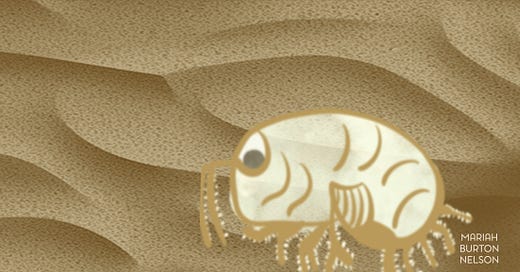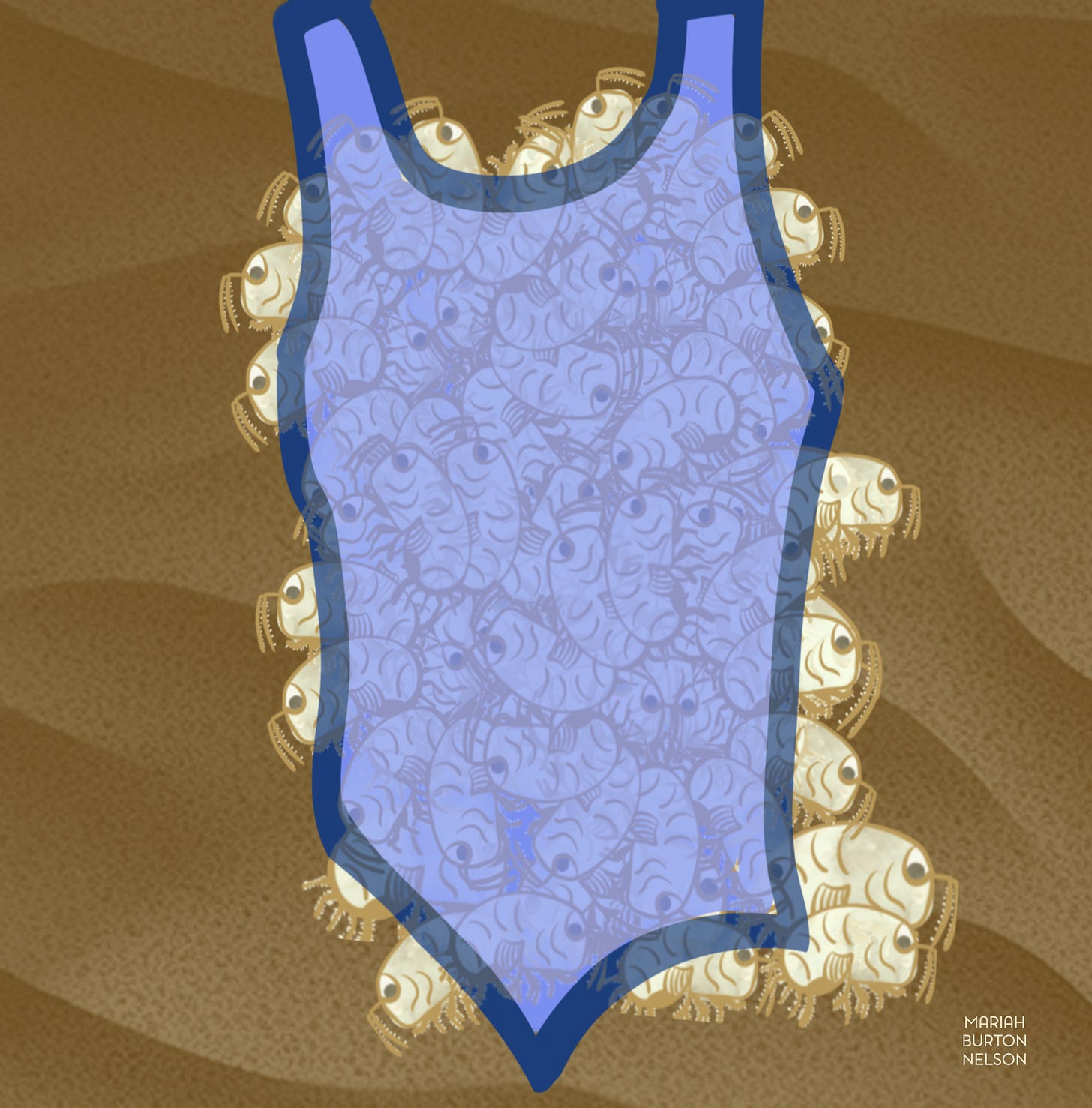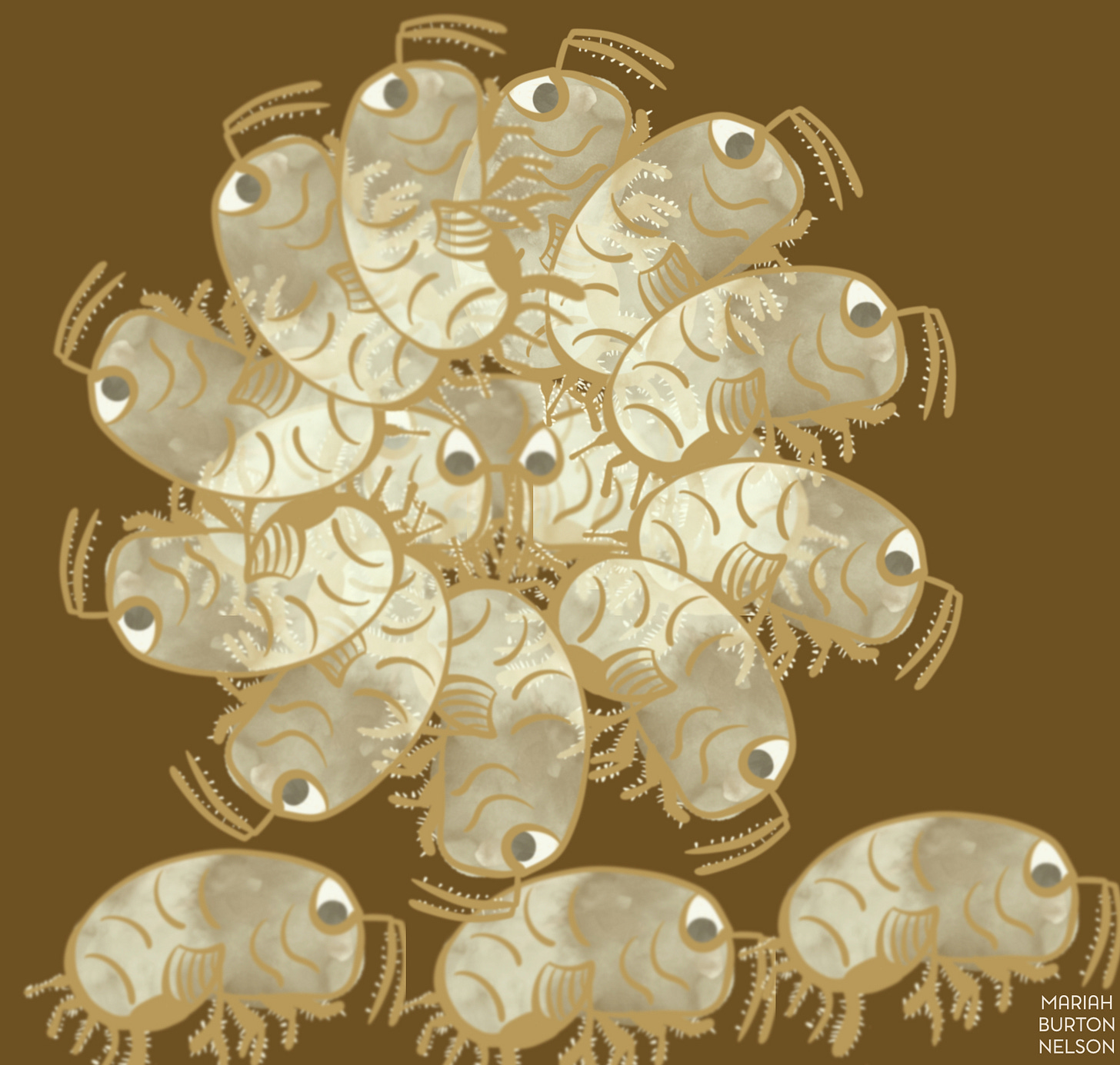Hi friends and welcome newcomers! This does have a happy ending. Sort of.
Wade into the ocean. Swim back and forth feeling strong and happy. Don’t worry about the prospect of sea lice attacking you like they did last summer.
Dive under waves. Bodysurf. Float. Feel the sun on your face. Marvel at the way the salty ocean embraces your buoyant body. You’ll need to recall this bliss later if you hope to ocean-swim ever again.
“Sea lice” is a misnomer for jellyfish larvae. They are unrelated to head lice.1
Notice stinging sensations on your skin. Is it kelp? This is the bargaining stage of a sea lice attack, when you want to stay in the ocean, high on swimming and swells, but irritating venom is becoming unignorable.
Do not freak out.
A mini-freak-out is understandable.
Tiny jellyfish tots get trapped inside swimmers’ bathing suits. As if blaming you, they sting you with “toxin-filled harpoons”2 called nematocysts.
Throwing decorum to the wind, slip your hand down your suit to brush the little boogers out. People do all sorts of undignified things at the beach, and you can accomplish this while underwater. It won’t do any good, though. For every one that leaves, another will enter.
Get out of the water.
“A red, itchy rash will appear over parts of your body covered by your hair or bathing suit. This can include your groin, rear end, chest, abdomen, neck, or back. You may have 200 stings or more.”3
If someone stops you as you’re running up the beach – a smiling sunbather who says, “I loved watching you swim!” then offers effusive compliments about your beautiful stroke – don’t slip your hand down your suit again. Scooping out handfuls of tiny white crawling critters will not go over well. Say, “Thank you. Excuse me.”
Shower at one of the overhead shower heads – if there is one. If there are only footbaths, you’re screwed.
“Other symptoms include headache, chills, fever, nausea, and abdominal cramps.”4
While showering, reach inside your suit again, grabbing and rinsing away translucent globs of blobs. Don’t worry: No one is paying attention to you. Except the people in line for the shower.
Next, if you can’t find a private beachside shower, which you probably can’t, find a private toilet stall with a sink. Lock the door. Strip off your suit. Scoop water on every part of your body. Stay in the stall until your blood pressure calms the F down.
“The problem is common between May and August along the southeast coast of the United States, the Gulf of Mexico and the Caribbean.”5
You’ll be glad you brought dry clothes, if you did. Last year, when you walked to the beach on a hot day wearing only a swimsuit, you had to walk all the way back to your condo wearing that same suit plus approximately 200 sea lice that kept stinging you, punishingly and disgustingly. This year you were smarter. Put the dry clothes on.
Go home. Shower again with soap.
“Wash your suit in hot water and toss it into the dryer to make sure all the larvae are gone. If you had a severe rash, you may want to get rid of the suit.”6
Plan your next ocean swim.
What? Won’t the sea lice find you again?
Maybe. But maybe not.
Outbreaks “occur intermittently between March and August” but “there have been many days when no infestations have occurred.”7
Don’t let the sea lice win.
“You might be “itchy and uncomfortable for a few days (or a week).” But hydrocortisone cream, calamine lotion, antihistamines, and anti-inflammatories can help. “There are usually no lasting effects.”8
There are risks worth taking, and ocean swimming is one of them.
"They aren't very intense, which is why we call them sea lice and not sea hornets or sea wasps."9
Remember the bliss.
Perspective: I’ve been an ocean swimmer my whole life, and I never experienced sea lice until 2011, 2023, and 2024. And never north of Delaware.10 11
Maybe try a different beach. Ask the lifeguard about today’s sea lice situation.12 13 Maybe don’t stay in too long.
I do those things in Delaware now, and it’s fine. Usually.
See you out there!
Other Stronger Women stories you might enjoy:
Recovery: A Love Story: Swimming Through Rough Waters with a Lifelong Friend
I Would Have Been Trans’ed: A Gender Nonconformist Wonders What If?
The Washington Post happens to offer a story about head lice today. In case you’re eager for more lice news: “The Lice Will Always Win.”
Theresa Machemer, “What’s Giving Some Beachgoers Rashes?” National Geographic, June 28, 2018.
Angelica Nelson, “What Are Sea Lice?” WebMD, June 16, 2024.
Angelica Nelson
Angelica Nelson
Angelica Nelson
Mary T. Russell, et. al., “Sea Lice or Seabather’s Eruption,” New Findings and Clinical Implications, undated.
Angelica Nelson
Dave Greenwood, director of public safety for Pensacola Beach, told the Pensacola News Journal, quoted in Amanda MacMillan, “What Are Sea Lice?” Health, January 18, 2024.
The cleanest ocean water I’ve experienced this summer was in Cape May, New Jersey.
But then an alert reader (aka my sister) sent this sea-lice alert from the Jersey Shore.
Some beaches fly purple warning flags, but most don’t want to scare away tourists.
Are these increasing infestations global-warming-related? Probably. Alas.










Yikes!! I've never heard of this! Great description and so gross!!! Also! I love the drawings!
Your story has brought back a wonderful memory from 2014. I went to Baja with a good friend to see the gray whale nursery lagoon. From a boat I reached out my hand to pet a baby and ended up with my hand in the baby's mouth. All of a sudden it looked like "tiny crabs" crawling all over my hand and arm. Seems they like to feed off the baby's baleen! I jammed my arm back in the water and scraped off the buggers. Still wouldn't have missed that baby whale for the world and wish I could see that good friend I lost last year.
Thank you for your stories. They always draw me in and feel so relatable.